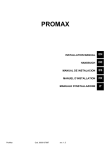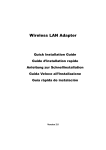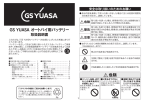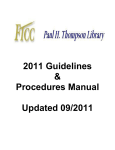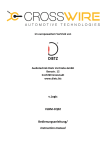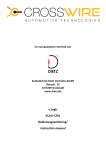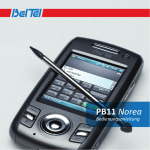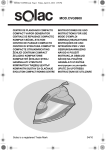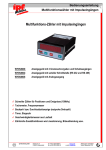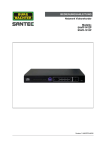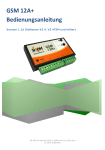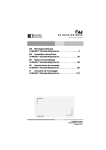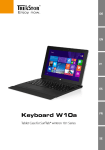Download Bedienungsanleitung
Transcript
Inhaltsverzeichnis / Content Index Garantie .................................................................................................................. 6 Fehler vermeiden! ................................................................................................... 6 Allgemeiner Warnhinweis: ....................................................................................... 6 Aktualitäts-Hinweis: ................................................................................................. 7 Lieferumfang .................................................................................................................. 8 Anschluss des Displays ................................................................................................ 10 Anschluss Signalquelle.......................................................................................... 10 Anschluss an Stromquelle ..................................................................................... 11 Nutzung Touch-Funktion ....................................................................................... 11 Nutzung Rückfahrkamera/Videokamera................................................................. 11 USB port ............................................................................................................... 11 Bedienung Display ....................................................................................................... 12 Fernbedienung: ..................................................................................................... 12 OSD-Menü-Bedienung: ......................................................................................... 12 Installation Touch-Display unter Windows ..................................................................... 17 Einstellen der faytech Touch - Software ........................................................................ 19 Fehler vermeiden / Fehler beheben .............................................................................. 26 Beim Anschluss: .................................................................................................... 26 Bei der Inbetriebnahme: ........................................................................................ 26 Technische Daten ........................................................................................................ 28 Timing-Paramter und Unterstützte VGA-Auflösungen ............................................ 28 7 Inch Touch Monitor ............................................................................................. 29 8 Inch Touch Monitor.................................................................................................30 10 Inch Touch Monitor ........................................................................................... 30 Anschlussbelegungen .................................................................................................. 32 2 Warranty: .............................................................................................................. 34 General warning: ................................................................................................... 36 Trouble-shooting: .................................................................................................. 36 Ongoing changes: ................................................................................................. 36 Components: ................................................................................................................ 37 To connect the signal source, ................................................................................ 39 Connect to power .................................................................................................. 39 Using the touch function ........................................................................................ 40 Using backview camera / Video camera ................................................................ 40 USB port ............................................................................................................... 40 Display Operation ......................................................................................................... 40 The remote control ................................................................................................ 40 OSD-Menu-Operation in VGA mode ...................................................................... 40 Installation of the Touch-Driver under Windows ............................................................ 45 Setting up the faytech Touch software .......................................................................... 48 Troubleshooting ........................................................................................................... 55 Physical Setup ...................................................................................................... 55 Startup .................................................................................................................. 55 Technical Data ............................................................................................................. 57 Timing-Paramter and supported VGA-resolution .................................................... 57 7 Inch Touch Monitor ............................................................................................. 58 8 Inch Touch Monitor..................................................................................................59 10 Inch Touch Monitor ........................................................................................... 60 Pin assignment............................................................................................................. 61 Kontakt / Contact .......................................................................................................... 61 3 4 DEUTSCH 5 GARANTIE Das Gerät wurde nach den modernsten Im Garantiefall nach diesen Bestimmungen Produktionsverfahren hergestellt und geprüft. wenden sie sich bitte an faytech. Ausgesuchte Komponenten und eine sorgfältige Produktion sorgen für eine Kontaktdaten gibt es am Ende der Bedienungsanleitung oder aktuell unter www.faytech.de. einwandfreie Funktion und lange Lebensdauer. Sollte Ihr Gerät dennoch Nach Ablauf der Garantiezeit können keine einen Defekt innerhalb der Garantiezeit Garantieansprüche mehr geltend gemacht aufweisen, wenden sie sich bitte direkt an werden. Der Nachweis des faytech. Die Garantiezeit beträgt 24 Monate, Garantieanspruches ist durch eine gerechnet von dem Tag des Kaufes, zu ordnungsgemäße Kaufbestätigung (Quittung nachfolgenden Bedingungen: oder Rechnung) zu erbringen. Der Garantieanspruch erlischt bei Eingriffen FEHLER VERMEIDEN! durch den Käufer oder durch Dritte. Schäden, die durch unsachgemäße Am Ende der Anleitung finden sie eine Behandlung oder Bedienung, durch falsches Übersicht über mögliche Anschluss- oder Aufstellen oder Aufbewahren, durch Bedienungsfehler. Bitte prüfen sie im unsachgemäßen Anschluss, sowie höhere Bedarfsfall zuerst diese Liste. Gewalt oder sonstige äußere Einflüsse entstehen, fallen nicht unter die Garantieleistung. ALLGEMEINER W ARNHINW EIS: Das Gerät auf keinen Fall mit Schmutz, Öl, Wir behalten uns vor, bei Reklamationen die Staub oder Wasser in Verbindung bringen. defekten Komponenten zu ersetzen oder Niemals das Gerät öffnen, nicht fallen lassen. das Gerät auszutauschen. Wenn sie einen verbrannten Geruch wahrnehmen oder das Gerät Geräusche Ausgetauschte Komponenten oder ausgetauschte Geräte gehen in unser Eigentum über. macht trennen sie es sofort vom Stromnetz. Zur Reinigung des Gerätes schalten sie es aus und nutzen sie ein trockenes, weiches Schadensersatzansprüche sind Tuch mit leichtem Druck. Nutzen sie das ausgeschlossen, soweit sie nicht auf Gerät zu Ihrer eigenen Sicherheit nicht Vorsatz oder grober Fahrlässigkeit des während der Autofahrt. Herstellers beruhen. 6 AKTUALITÄTS-HINW EIS: faytech produziert seine Displays in China mit deutschem Entwicklungs- Know-how und deutschem Qualitätsmanagement vor Ort. Ihr Feedback fließt direkt in die Weiterentwicklung unserer Produkte mit ein. Die stetige Produktions- und Produktverbesserung ist unser oberstes Ziel. Aus diesem Grund kann es in unseren Produkten bereits Verbesserungen geben, die noch nicht in den jeweiligen Bedienungsanleitungen enthalten sind. Abweichungen Ihres Produktes zu dieser Bedienungsanleitung bedeuten in der Regel Spezifikations- und Produktverbesserungen. Wenden Sie sich bei Fragen bezgl. Abweichungen bitte an unseren Support oder besuchen Sie unsere Internetseite unter www.faytech.de. 7 LIEFERUMFANG 16 20 21 22 1.USB-Port 2. Kopfhöhrerausgang 3. Lautsprecher 4. (+)/rechts: spiegelt das Bild (4 Modi), erhöht Lautstärke und markierte Werte im Menü, navigiert durch das OSD-Menü (nach unten) 5. (-)/links: öffnet Lautstärke-Menü, verringert die Lautstärke und markierte Werte im Menü, navigiert durch das OSD-Menü (nach oben) 6. AUTO: Stellt das Display automatisch optimal auf die aktuelle Signalquelle ein. 7. SOURCE: schaltet die Eingangssignale HDMI, AV, SV, VGA durch – bitte stellen Sie unbedingt den richtigen Kanal ein, sonst haben Sie kein Signal! 8. MENU: öffnet das Menü, bestätigt Vorgänge im OSD-Menü 9. BRIGHTNESS: Schalten Sie voreingestellte Helligkeitswerte des Panels durch 10. Lautsprecher 11. Status-LED: rot--kein Signal; gelb—StandBy; grün—An; Signal Aus--keine Power oder Bildanpassung an das Signal 12. POWER: Display Ein/Aus 13. Infrarotempfänger 14. Befestigungsloch 15. Kordelaussparung zur Befestigung des Touch-Stifts am Display mit einer Schnur 16. Standfuß 17. Lange Metallschiene mit Befestigungsloch auf der Unterseite liegt dem Lieferumfang bei 18. Metallschiene 19. VESA-75 Befestigungslöcher 20. Touch-Stift 21. Treiber-CD inkl. ausführlicher Bedienungsanleitung 22. Fernbedienung 8 23 24 25 26 27 V1.1 V1.1 28 29 30 31 32 33 34 35 23. USB-Anschluss für Touch- und USB-HUB-Funktion 24. POWER-Anschluss inkl. Auto-Kamera-Funktion (z.B. Rückfahrkamera) 25. HDMI-Eingang 26. VGA- und Audio-Anschluss 27. Video- und Audio-Anschluss 36 28. USB-Stecker für Touch- und USB-HUB-Funktion 29. Funktion Auto-Kamera-Funktion, siehe Kapitel Nutzung Rückfahrkamera/Videokamera 30. 12-36V DC-IN: 5.5mm (GND) /2.5mm (+) 37 31. HDMI-Kabel (NICHT IM LIEFERUMFANG ENTHALTEN!) 32. PC-Audio 33. VGA-Kabel 34. S-VHS-Kabel 35. gelb: Video1 schwarz: Rückfahrkamera weiß: Video-Audio-Links rot: Video – Audio – Rechts 36. Netzteil 37. 12V-Adapter 38. Serieller Anschluss für die Touchfunktion 38 39. Spezialkabel für seriellen Touchanschluss, (NICHT IM LIEFERUMFANG ENTHALTEN!) 39 Revisionshistorie: V1.0: produziert von 2011 bis Juli 2013 V1.1: produziert ab August 2013, Änderung: VGA-Anschluss, Produktbezeichnung (V1.1) 9 ANSCHLUSS DES DISPLAYS Um Ihr faytech Display ordnungsgemäß in Betrieb zu nehmen müssen Sie es mit mindestens einer Signalquelle, einer Stromversorgung und für den Gebrauch der Touchfunktion optional mit dem USB-Port Ihres PCs verbinden. ANSCHLUSS SIGNALQUELLE Sie haben folgende Möglichkeiten: an PC: Verbinden Sie das VGA- Kabel Ihres faytech-Monitors mit dem VGA- Ausgang ihrer PC-Grafikkarte. Bitte wechseln Sie über SOURCE auf VGA, damit Sie ein Bild auf dem Display sehen. an PC: haben Sie einen DVI-/HDMI-Ausgang an Ihrem PC nutzen Sie entsprechend den HDMI-Eingang des faytech Touch-Monitors, bei DVI benötigen Sie noch einen DVI auf HDMI-Adapter. Bitte wechseln Sie über SOURCE auf HDMI, damit Sie ein Bild auf dem Display sehen. an DVD-Player / Kamera / Video-Quelle: Verbinden Sie den Video oder den S-Video-Eingang (oder beide, beschriftet mit Video bzw. S-Video) mit einer entsprechenden Video-Quelle. Bitte schalten Sie unbedingt die Video-Quelle aus bevor Sie die Kabel miteinander verbinden. Wechseln Sie über SOURCE auf den Video-Kanal-Eingang. Daneben hat das Display zwei Stereo-Audio-Eingänge, einen für den PC (3,5mm Audio-In) und einen (2x Cinch) für die beiden Video-Eingänge (Ton wird auf beiden Video-Kanälen eingespielt). Der Ton über die Lautsprecher wird nur ausgegeben, wenn auch jeweils ein Bildsignal anliegt. Werden Kopfhörer/Lautsprecher angeschlossen wird das Tonsignal nicht über die eingebauten Lautsprecher wiedergegeben. Tipp: Sie können das Display gleichzeitig über alle fünf Signalquellen anschließen. Über SOURCE auf dem Display oder über den Fernbedienungsknopf schalten Sie zwischen den einzelnen Signaleingängen durch. 10 ANSCHLUSS AN STROMQUELLE Per Steckverbinder können Sie Ihr faytech Display an das mitgelieferte 220V Netzteil oder den mitgelieferten 12V-Adaptor anschließen, bitte nutzen Sie dafür das Stromadapterkabel. Vorgehen bei Anschluss an eine andere 12V-36V Quelle: Gerne können Sie das Display auch über eine andere 12V-36V Quelle betreiben. Bitte achten Sie darauf, dass die Polung richtig ist (+ Innen) und das Netzteil ausreichend dimensioniert ist (1,5A bei 12V). Wenn Sie das Stromadapterkabel nicht nutzen wollen beachten Sie bitte die Anschlusssteckerbelegung im Kapitel Anschlussbelegung. NUTZUNG TOUCH-FUNKTION Verbinden Sie das USB- Kabel mit dem USB- Anschluss Ihres PCs (nachdem Sie bei der Software-Installation dazu aufgefordert wurden). Die Touch-Monitorserie unterstützt auch die Touch-Nutzung über den seriellen Port. Bitte bestellen Sie hierfür bei faytech ein Spezialkabel oder schließen Sie den seriellen Port gem. Anschlussdefinition im Kapitel Anschlussbelegung an. NUTZUNG RÜCKFAHRKAMERA/VIDEOKAMERA Der Touch-Monitor schaltet automatisch auf Video 2 um, wenn auf PIN5 des Strom adapterkabels eine Spannung zwischen 12V und 36V liegt. GND 12-36V Signal (PIN 5) 12-36V DC-IN (5.5mm/2.5mm) INNENPOL + USB PORT Auf der Frontseite des Touch-Monitors gibt es einen USB-Port. Zur Nutzung muss das USB-Kabel mit dem PC verbunden sein. Sie können den Port wie jeden anderen USB-Port nutzen. 11 BEDIENUNG DISPLAY FERNBEDIENUNG: Die Fernbedienung funktioniert analog. Zur Inbetriebnahme entfernen Sie zunächst die dünne Plastikscheibe auf der Rückseite damit der Kontakt zwischen Batterie und Fernbedienung hergestellt wird. OSD-MENÜ-BEDIENUNG: Die Menü-Bedienung Ihres faytech-Displays ist einfach und logisch. Sie haben drei Bedienknöpfe. MENU, +/ -. Mit MENU rufen Sie das OSD-Menü auf, mit +/ – navigieren Sie durch die jeweiligen Menüpunkte, ins Untermenü gelangen Sie wieder über das Drücken von MENU. Einen Wert ändern Sie, in dem Sie Ihn mit +/- ansteuern und dann MENU zur Änderung des Wertes drücken. Der angesteuerte Menüpunkt erhält nun eine neue Farbmarkierung, über +/ – verändern Sie nun seinen Wert. Drücken Sie erneut MENU werden die Änderungen gespeichert und Sie navigieren mit +/- wieder innerhalb der Registerkarte. Kehren Sie zum Hauptmenüpunkt zurück in dem Sie jeweils den Punkt EXIT im Untermenü an navigieren und MENU drücken. Im Folgenden wird das VGA-Menü beschrieben. Das AV-Menü hat keine Bildeinstellungen. Die Funktionen Auto Display Einstellung und Auto Farbeinstellung sowie Farbtemperatur sind nicht vorhanden, stattdessen gibt es die Funktionen Sättigung und Farbton. Tipp: Bevor Sie das Menü nutzen stellen Sie am besten zuerst die Deutsche Sprache wie folgt ein: Drücken Sie 1x die Taste MENU, dann 2x +, wieder 2x MENU, 1x +, es wird „Deutsch“ angezeigt. Speichern Sie mit MENU und navigieren Sie weiter gem. folgender Anleitung. 12 Farbeinstellungen Auto Display Einstellung: Stellt das Display automatisch optimal auf die aktuelle Auflösung Ihrer Grafikkarte ein. Sind Sie mit der Auto-Einstellung nicht zufrieden optimieren Sie bitte manuell. Auto Farbeinstellung: Optimiert automatisch die Farbtemperatur Ihres faytech Displays. Gerne ändern Sie auf Wunsch die Farbwerte des Displays manuell. Helligkeit: Erhöht oder senkt den Helligkeitswert Ihres Displays. Kontrast: Erhöht oder senkt den Kontrastwert Ihres Displays. 13 Farbtemperatur: Hier können Sie aus drei vorgegeben Farbtemperaturräumen wählen oder selber einen Farbtemperaturraum für die Grundfarben Rot, Grün, Blau festlegen Sättigung: (Nur im AV-Mode) Erhöht Farbsättigung (stärkere Farben) oder verringert Farbsättigung. Farbton: (Nur imAV-Mode) Hier können Sie den Farbton (wärmere Farben oder Kältere Farben) ändern. Exit: Sie können hier ins Haupt- oder Submenü zurückkehren. Bildeinstellungen (nicht verfügbar im AV-Mode) Horiz. Position: Verschieben Sie die Position des Displaybildes nach links (-) oder rechts (+). Vertik.Position: Verschieben Sie die Position des Displaybildes nach unten (-) oder oben (+). Phase: Lässt Sie die Halbbilddarstellung im Videobereich optimieren. 14 Horiz. Grösse: Verkleinern o. vergrößern Sie das Displaybild Ihres faytech Monitors mit -/ +. Exit: Sie können hier ins Haupt- oder Submenü zurückkehren. Menü Einstellungen Sprache Ändern Sie hier die Sprache des OSD-Menüs. OSD Horiz. Position: Verschieben Sie die Position des OSD-Menüs nach links (-) o. rechts (+). OSD Vertik-Position: Verschieben Sie die Position des OSD-Menüs nach unten (-) o. nach oben (+). OSD auto.Ausschalten: Hier stellen Sie die Zeit ein, nach deren Ablauf das OSD-Menü automatisch beendet wird. Durchsichtigkeit: Hier können Sie verschiedene Durchsichtigkeitsstufen für Ihr OSD-Menü auswählen. Exit: Sie können hier ins Haupt- oder Submenü zurückkehren. 15 Soundeinstellungen Lautstärke: Verändern Sie die Lautstärke der eingebauten Lautsprecher. Mit - verringern Sie die Lautstärke, mit + erhöhen Sie diese. Stumm: Schalten Sie die Lautstärke an/aus. Exit: Sie können hier ins Haupt- oder Submenü zurückkehren. Einstellungen Werkseinstellungen: ktivieren Sie diese Einstellung wird das Display zurück auf die Werkseinstellungen esetzt, alle Änderungen, die Sie gemacht haben, werden gelöscht. . 16 Exit: Sie können hier ins Haupt- oder Submenü zurückkehren. Exit Schalten Sie hier das OSD Menü aus. INSTALLATION TOUCH-DISPLAY UNTER W INDOW S 1. Legen Sie die mitgelieferte CD in Ihr CD-Laufwerk ein. 2. Wechseln Sie über den Explorer auf der CD in das passende Unterverzeichnis (Touch-Driver, dann das richtige Betriebssystem) und öffnen Sie dort die Installations-Datei setup.exe. Sie sollten nun folgenden Bildschirm sehen: Um die Installation mit allen Standardoptionen abzuschließen, können Sie bei allen folgenden Dialogen einfach „Next >“ drücken. Dieses Vorgehen empfehlen wir ausdrücklich! Über „Cancel“ können Sie die Installation jederzeit abbrechen, über „< Back“ können Sie jeweils zum vorherigen Dialog zurück wechseln. Bitte beachten Sie! Der Installationsvorgang ist auf Englisch, im späteren Programm wird die Sprache aber automatisch auf Ihre gewählte Landessprache eingestellt. 3.„Welcome to the InstallShield Wizard for TouchKit“: Drücken sie „Next“ wenn sie das Programm installieren möchten, beenden sie nach Möglichkeit alle anderen Programme. 17 4.„Setup Type“: Aktivieren Sie das Kästchen nur, wenn Sie auch die PS/2-Treiber mit installieren wollen. Ihr Display ist in der Regel ein USB-Touch-Display, entsprechend sollten Sie diese Option NICHT wählen. Der PS/2-Treiber funktioniert reibungslos mit PS/2-Mäusen zusammen, mit anderen Geräten am PS/2-Port können Kompatibilitätsprobleme auftreten. 5.„Setup Type“: Wir empfehlen die Einstellung „None“. „Every system boot up“ führt eine Kalibrierung bei jedem Systemstart durch. Da die Kalibrierung in der Regel über einen langen Zeitraum konstant bleibt, ist dieses Vorgehen unnötig. Bei der Aktivierung des Kästchens „Next system boot up“ wird die Kalibrierung beim nächsten Systemneustart durchgeführt. Sie können jederzeit eine Kalibrierung im später installierten TouchKit-Programm durchführen, siehe auch Einstellen der Touch-Software. Drücken Sie dann „Next“. 6.„TouchKit - InstallShield Wizard“: Schließen Sie jetzt das USB-Kabel an und drücken Sie „OK“. Falls sich der „Neue Hardware gefunden“ Dialog von Windows öffnet, beenden Sie diesen bitte wieder. 18 7. „Setup Type“: Verwenden Sie mehrere Monitore aktivieren Sie dieses Kontrollkästchen, siehe auch Einstellen der Touch-Software. 8.„Choose Destination Location“: Wählen Sie ein Installationsverzeichnis über „Browse“ oder drücken Sie „Next“. 9.„Select Program Folder“: Geben Sie dem Programm einen Namen oder nutzen Sie die Standardeinstellung und drücken Sie „Next“. 10.„Setup Status“: Die Installation wird automatisch mit den ausgewählten Einstellungen durchgeführt. Warten Sie einfach die Fertigstellung ab. 11. Die Installation ist erfolgreich abgeschlossen wenn folgendes Fenster erscheint: Wird kein USB Controller angezeigt, ziehen Sie bitte einmal das USB-Kabel aus Ihrem PC und verbinden Sie es erneut, ggfls. müssen Sie den PC neu starten. Weitere Hilfe gibt es sonst in der Rubrik Fehler vermeiden/Fehler beheben. EINSTELLEN DER FAYTECH TOUCH - SOFTWARE Sie starten das Verwaltungsprogramm über Start, Programme, TouchKit und dann Configure Utility. Die Touch-Software besitzt sieben Registerflächen die im Folgenden kurz erklärt werden. 1.Allgemein Das Startfenster „allgemein“ gibt Information darüber, ob ein oder mehrere Touch-Controller gefunden bzw. installiert wurden. 19 Wird nach der ersten Installation kein Touch-Controller angezeigt (entgegen der Abbildung unter Installation Touch Display unter Windows), ziehen Sie bitte einmal den USB-Stecker von Ihrem PC ab und verbinden Sie die Geräte erneut. 2.(die) Einstellung In den Einstellungen können Sie zunächst unter (der) Signalton die Toneinstellungen des Touch-Panels vornehmen. Über (die) Frequenz und (die) Dauer ändern Sie die Tonhöhe und Länge des Signaltons. Die Änderungen werden nach einem。klick auf „übernehmen“ wirksam. Unter Linearisierung Art können Sie die Häufigkeit der Linearisierungspunkte unter (die) Werkzeuge, festlegen. Linearisierung Bei einer 25-Punkte Linearisierung ist die Abweichung des Panels vom Druckpunkt geringer als bei einer 9-Punkte Linearisierung. In der Regel sind faytech Displays von Fabrik aus richtig eingestellt und sollten nicht linearisiert werden müssen. Über die Doppelklick-Geschwindigkeit stellen Sie ein, wie schnell Sie hintereinander auf das gleiche Objekt klicken müssen, um einen Doppelklick auszulösen. Je kuerzer<<, desto schneller müssen Sie drücken, je >>laenger, desto mehr Zeit können Sie zwischen Ihren beiden Klicks vergehen lassen, um einen Doppelklick auszulösen. Entsprechendes gilt auch für die Doppelklick-Position. Wählen Sie kleiner<<, müssen Sie für einen erfolgreichen Doppelklick die gleiche Fläche zwei Mal sehr genau treffen, wählen Sie >>groesser wird auch ein Doppelklick ausgeführt, wenn Sie beim zweiten Klick nicht ganz genau die gleiche Fläche treffen wie beim ersten Berühren. Rechts vom Maussymbol können Sie die unterschiedlichen Maus-Modi einstellen. Die intuitive Touch-Bedienung entspricht dem Normal-Modus. Normal-Modus: In diesem Modus verhält sich das Touchpanel wie eine gedrückte Maus, wenn Sie es mit Stift oder Finger berühren. 20 Klick bei Berührung: Es wird nur beim ersten Berühren ein Klick erzeugt, danach folgt der Mauszeiger der Fingerbewegung. Für einen neuen Mausklick muss das Display losgelassen und neu gedrückt werden. Klick beim Loslassen: Konträr zur Funktion Klick bei Berührung wird ein Klick beim Loslassen des Displays erzeugt. Klick bei Berührung ohne den Mauszeiger zu bewegen: Es wird auf den ersten Druckpunkt ein Klick erzeugt, der Mauszeiger folgt der Finger/Stiftbewegung nicht. Klick beim Loslassen ohne den Mauszeiger zu bewegen: Der Mauszeiger folgt der Berührung nicht, beim loslassen des Touch-Panels wird an dieser Stelle ein Klick erzeugt. Rechts von den Maus-Modi gibt es die Schaltfläche Option. Folgende Einstellmöglichkeiten gibt es für Ihr faytech Display in diesem Untermenü: (die) Funktion Aktiviert die constant Touch-Funktion: reduziert Systemlast durch das Zusammenfassen mehrerer Touch-Panel Berührungen (Druckabweichungen) zu einem Mausklick. Aktiviert die automatische right Klick- Funktion: schaltet den automatischen Doppelklick bei längerem Drücken des Displays ein. Aktiviert die Touch-Funktion: schaltet die Touch-Funktion an/aus ACHTUNG! Die Touchfunktion funktioniert nach dem Ausschalten nicht mehr! Aktiviert die Mauszeiger- Stabilisierung: filtert Druckabweichungen bei der Bedienung des Displays heraus und führt so zu einer ruhigeren und saubereren Mauszeigerbewegung. Mit Dauer-Touch kleiner<< bzw. >>groesser verändern Sie die Größe der Touchfläche, innerhalb derer die Funktion „rechte Maustaste gedrückt“ aufgerufen wird oder nicht. Je kleiner der Wert ist, desto weniger dürfen Sie Ihren Finger während dem Drücken des Touch-Panels bewegen, um das Drücken der rechten Maustaste zu simulieren. 21 Bei der nächsten Funktion stellen Sie mit kuerzer<< bzw. >>laenger das Intervall in ms (Millisekunden) ein, nachdem die Funktion „rechte Maustaste gedrückt“ ausgeführt wird, wenn Sie mit dem Finger oder einem Stift auf die Touchfläche drücken. 3.(die) Werkzeuge In dieser Registerkarte können Sie Ihr faytech Touch-Panel erneut mit den Funktionen 4-Punkte-Kalibrierung, Loeschen und Kalibrieren, Linearisierung und Zeichen-Test einstellen. In der Regel reicht bei Inbetriebnahme, wenn überhaupt nötig, die 4-Punkte-Kalibrierung aus. Mit der Applikation Zeichentest können sie sich mit der Nutzung des Touchscreens vertraut machen und die Funktionalität überprüfen. Drücken Sie die Funktion 4-Punkte-Kalibrierung wird die Fläche des Touch- Monitors weiß, folgende Informationen werden eingeblendet: Drücken Sie jeweils auf das rot-grün blinkende Fadenkreuz mit Finger oder Stift, bis es aufhört zu blinken. Haben Sie lange genug auf das Fadenkreuz gedrückt, werden insgesamt drei weitere Fadenkreuze eingeblendet. Unterhalb des Fadenkreuzes läuft ein Fortschrittsbalken mit. Bitte drücken Sie auf das Fadenkreuz bevor der gelbe Balken durchgelaufen ist, sonst wird die Kalibrierung abgebrochen. 22 Die Funktionen Loeschen und Kalibrieren und Linearisierung arbeiten nach dem gleichen Prinzip. Führen Sie diese beiden Funktionen bitte nur durch, wenn Sie trotz 4-Punkte-Kalibrierung und Optimierung im Register „Koeffizient im Randbereich“ kein zufriedenstellendes Ergebnis hinsichtlich der Genauigkeit Ihres faytech Touch-Displays erzielen. Mit der 25-Punkte- Linearisierung stellen Sie Ihren Touch-Monitor mit der größtmöglichen Genauigkeit ein. Unter Einstellung, Linearisierung Art können Sie im Programm festlegen, ob Sie eine 25-Punkte-Linearisierung oder eine 9- Punkte-Linearisierung an dieser Stelle durchführen möchten. Mit Hilfe der Applikation Zeichen-Test können Sie sich mit der Nutzung des Touchscreens vertraut machen. Drücken Sie auf das linke, blaue Kästchen Löschen Sie Ihre Touchscreen-Eingaben, mit einem Klick auf das rechte blaue Kästchen beenden Sie das Zeichenprogramm. 4. Display Multi-Monitor-Einstellungen Die Registerkarte Display ist für Sie wichtig, wenn Sie mehrere Displays gleichzeitig nutzen. Sie können bis zu vier faytech Touch-Displays gleichzeitig verwenden, zum Beispiel aber auch ein (Nichttouch-) Display und ein Touchdisplay nutzen, wie es im folgenden Bild zu sehen ist. Im Beispiel ist der Touch-Monitor das Display „1“, das zweite Display „2“ ist ein normaler Monitor. Beide haben die gleiche Auflösung, das Touchdisplay ist der primäre Monitor. 23 Ist die Mehrfach-Monitor-Funktion NICHT aktiviert, wird stets der primäre Monitor als Touch-Screen-Monitor gesetzt. Aktivieren Sie die Funktion, können Sie einen der angeschlossenen Monitore als Touch-Screen-Monitor auswählen. Drücken Sie dafür per Doppelklick auf den gewünschten Monitor und bejahen Sie die Frage im Pop-Up-Fenster: Nach Bestätigung werden Touch-Panel-Berührungen auf dem gewählten Monitor als Mausklicke simuliert. Ist die Funktion „Den Touch-Sensor immer an das Haupt-System anpassen“ aktiviert, schaltet das Programm die Touch-Funktion automatisch auf den primären Monitor, wenn nur ein Monitor angeschlossen wird. Über die Funktions-Modus Einstellungen können Sie die Größe der Touch- Fläche auf Ihrem faytech Touch-Monitor einstellen bzw. begrenzen. Wählen Sie z.B. die Funktion „rechter Bildschirm“ aus funktioniert nach einer neuen Kalibrierung nur noch die rechte Seite als Touchfläche. Unter „anders“ und dann auf ->> können Sie weitere Modi einstellen oder individuell eine Touch- Fläche definieren. 5.Koeffizient im Randbereich Feinjustierung der Touchfläche Über dieses Register können Sie Ihre Touch-Fläche feinjustieren. Dies ist sehr nützlich, wenn Sie z.B. Probleme haben, den Rand des Touch-Displays sauber zu treffen. Im Beispielbild sehen Sie, dass die Grenzwerte in der oberen Bildschirmhälfte und der unteren Bildschirmhälfte korrigiert wurden. Wenn Sie z.B. im oberen, rechten Bereich Probleme haben, einen 24 Punkt genau zu treffen, vergrößern Sie die oberen und rechten Grenzwerte (>>groesser). Übernehmen Sie die Änderung und testen Sie am besten unter (die) Werkzeuge, Zeichen-Test, ob Sie den Punkt nun besser treffen. Genau so können Sie die X-Achse und die Y-Achse über die beiden Versatz-Optionen verschieben und so den Touch-Punkt/den Mauszeiger verschieben. Die Funktion „Unterstütze Kantenausgleich“ optimiert softwaregesteuert die Touch-Erkennung in den Eckbereichen Ihres faytech Touch-Panels. Sie sollten diese Funktion aktivieren. 6.Registerkarten (die) Hardware, Infos über Die beiden letzten Registerkarten stellen lediglich informative Inhalte zur Verfügung, Einstellmöglichkeiten gibt es in diesen Registern keine. Registerkarte (die) Hardware informiert über die Bauart des faytech Touchdisplays und die verwendete Firmware. Die Registerkarte Infos über zeigt die Treiberversion und Informationen zum Programmierer der Software an. 7.Touchkit-Programm in der Taskleiste Über das TouchKit-Symbol in der Taskleiste können Sie mit dem rechten Mausklick folgende Schnell-Änderungen an den Touch-Kit-Einstellungen vornehmen. Die einzelnen Funktionen sind bereits in diesem Kapitel beschrieben worden. Zusätzlich können Sie mit der Funktion „Schalter anzeigen“ eine Maus in der rechten, unteren Bildschirmhälfte einblenden. Die rote Markierung zeigt, welcher Mausknopf beim Berühren des Touch-Displays simuliert wird. 25 Mit einem Klick auf den linken oder rechten Mauszeiger der Animation verändern Sie entsprechend das Klick-Verhalten des Touch-Panels bei Berührung. Blenden Sie diese Funktion ein, wenn Sie einfach zwischen rechtem und linken Mauszeiger hin- und herwechseln möchten. FEHLER VERMEIDEN / FEHLER BEHEBEN Durch die vielen Anschluss- und Einsatzmöglichkeiten des Displays besteht die Gefahr, dass es bei der Inbetriebnahme zu Problemen kommt. Im Folgenden stellen wir die häufigsten Fehlerursachen und Fehlerlösungen dar: BEIM ANSCHLUSS: Gehen Sie beim Anschluss der Kabel bitte vorsichtig vor und achten Sie darauf, dass Sie die richtigen Stecker in der richten Ausrichtung nutzen. Bildfehler oder Nichtfunktionen werden häufig durch Steckfehler ausgelöst. Stellen Sie einen Fehler fest trennen Sie das Display vom Strom und überprüfen Sie die einzelnen Stifte in den Kabeln auf Unversehrtheit. Gerne tauschen wir ihnen ein defektes Kabel aus, schicken Sie deswegen nicht das Display zurück. vermeiden Sie unbedingt Kurzschlüsse! Achten Sie penibel darauf, dass nach Anschluss der Stromquelle keine Kabel frei rumliegen. Wechseln Sie Steckverbindungen nur, wenn kein Strom anliegt. Versorgen Sie das Display ausschließlich mit 12V-36V DC-Strom. Eine höhere oder geringere Voltzahl beschädigt das Display unwiderruflich! Achten Sie auf die richtige Verpolung! BEI DER INBETRIEBNAHME: Bitte beachten Sie, dass Sie zunächst den Power-Knopf drücken und dann ggfls. noch über SOURCE auf das richtige Eingangssignal HDMI/AV/SV/VGA wechseln müssen, um ein Signal zu erhalten. Ist zunächst keine Signalquelle angeschlossen meldet das Display „kein Signal“ und geht nach einer kurzen Zeit automatisch aus. Display bleibt schwarz: Anschlussfehler: Bitte überprüfen Sie zunächst noch mal, ob alle Signalquellen richtig angeschlossen sind. Auflösungs/Ansteuerungsfehler: 26 Bei der Ansteuerung der Displays gibt es die häufigsten Probleme. Das Display unterstützt die unter den Technischen Daten angegebenen Bildformate. Gerade beim gleichzeitigen Betrieb von zwei Displays an einem PC oder dem Anschluss von einem zusätzlichen Display an ein Notebook entstehen häufig Komplikationen, die in der Hard- und Software des PCs begründet sind. Schließen Sie das Display am besten immer zunächst einzeln bei einer Auflösung von 800x600 bei 60Hz an. Testen Sie von dieser Auflösung ausgehend die für Sie beste Konfiguration. Beachten Sie, dass erweiterte Desktops zunächst häufig schwarz sind – entsprechend ist auch das Display zunächst schwarz, wenn Sie es als erweiterten Desktop konfigurieren. Tipp: Nutzen Sie das Display am besten in folgenden Auflösungen: 7“: 800x480 oder 800x600 bei 60Hz, 8“ 800x600 bei 60Hz, 10“ 1024x768 bei 60Hz. Netzteil-Fehler: Reagiert das Display auf keine Eingaben, kann es einen Fehler bei der Stromversorgung geben. Bitte überprüfen Sie zunächst ihre Anschlüsse und eine andere Stromquelle, bevor sie das Display einschicken. Gerne tauschen wir ihnen unkompliziert ein defektes Netzteil aus. Streifen/Fehler im Bild Pixelfehler: Die Displays werden ausführlich getestet und ohne Pixelfehler ausgeliefert. Hat ihr Display trotzdem einen Pixelfehler wenden Sie sich bitte an unseren Support. Schrift ist schwer zu lesen, Bild sieht unscharf aus: Das Display-Bild ist in der Original-Auflösung (siehe technische Daten) klar und deutlich zu lesen. Bei höheren Auflösungen interpoliert das Display. Dies führt zu Ungenauigkeiten in der Darstellung und Pixelschwingungen. Streifen/Fehler im Bild: Beim Anschluss des Displays über z.B. ein PC- Netzteil entstehen häufig leichte Flackereffekte. Dies liegt an den Störströmungen, die das Netzteil mit aussendet. Bitte prüfen Sie alternative Stromquellen oder achten Sie auf Störquellen, um das Bild zu verbessern. Bild ist auf dem Kopf: Drücken Sie (bei Anliegen eines Signals) die + Taste. Hiermit schalten Sie vier verschiedene Modi durch (Original, Oben/Unten gespiegelt, links/rechts gespiegelt) 27 TECHNISCHE DATEN Änderungen im Sinne des technischen Fortschritts vorbehalten TIMING-PARAMTER UND UNTERSTÜTZTE VGA-AUFLÖSUNGEN Timing-Parameter: 7" : Dot Clock:33.3MHZ Analog Scanning Frequency (H, V) 31~74KHZ, 60~85HZ Digital Scanning Frequency (H, V) 31~45kHZ, 59~61HZ 8": Dot Clock:40MHZ Analog Scanning Frequency (H, V) 31~74KHZ, 60~85HZ Digital Scanning Frequency (H, V) 31~45kHZ, 59~61HZ 10": Dot Clock:56MHZ Analog Scanning Frequency (H, V) 31~74KHZ, 60~85HZ Digital Scanning Frequency (H, V) 31~45kHZ, 59~61HZ Unterstützte VGA-Auflösungen: 640x480, 60Hz, 75Hz, 85Hz 1440x900, 60Hz 800x480, 60Hz, 75Hz, 85Hz 1680x1050, 60Hz 800x600, 60Hz, 75Hz, 85Hz 1600x1200, 60Hz 1024x768, 60Hz, 75Hz, 85Hz 1920x1080, 60Hz 1280x720, 60Hz 1920x1200, 60Hz 1280x768, 60Hz 720x576, 50Hz 1280x1024, 60Hz 1280x720, 50Hz 1360x768, 60Hz 1920x1080, 50Hz 28 7 INCH TOUCH MONITOR Displagehäuse (cm): 17,90 x 12,30 x 2,80 Bildschirmdiagonale (Zoll/cm): 7/17,78 Display (cm): 15,40 x 8,59 Befestigung (cm): Befestigungsschiene, zusätzlich VESA-75-Bohrung Brutto-Gewicht (inkl Verpackung, kg): 1,80 Netto-Display-Gewicht (kg): 0,40 Seitenverhältnis: 16:9 Physikalische Auflösung: 800 x 480 Maximal darstellbare Auflösung: 1920 x 1200 Anzahl darstellbare Farben: 16.7M Helligkeit (cd/m2): 250 Kontrast: 500:1 Typische Reaktionszeit Tr/Tf (ms): 10;15 Betrachtungswinkel horizontal; vertikal 140;120 (°): Betriebsspannung (V): 8~36 Stromverbrauch (W): 4 Stand-By-Verbrauch (W): <0,5 Betriebstemperatur (°C): -25~+75 Touch-Panel: 4-wire resistive Touch Anschlüsse: 1 x USB port, 1 x serial port Touch-Panel-Treiber: Windows, Linux, Mac Lebensdauer Touch-Panel (Berührungen): >1 000 000 Reaktionszeit Touch-Panel (ms): <10 Oberflächenhärtegrad: 3H Druckstärke (g): 20~150 Anschlüsse, Bild: 2 x Video(1x back cam view), 1 x S-Video, 1 x VGA, 1 x HDMI 1.1 (inkl. HDCP) Anschlüsse, Audio: 3 x Audio-In, 1 x Lautsprecher-Ausgang Anschlüsse: USB-Port / DC-IN USB Port / 8-36V DC-IN Weitere Eigenschaften: OSD-Menu, Lautsprecher, Fernbedienung, Touch-Stift, KFZ-Stromadapter, Treiber-CD, Anleitung zur Inbetriebnahme 29 8 INCH TOUCH MONITOR Displagehäuse (cm): 19,80 x 16,80 x 3,20 Bildschirmdiagonale (Zoll/cm): 8/20,32 Display (cm): 16,20 x 12,15 Befestigung (cm): Befestigungsschiene, zusätzlich VESA-75-Bohrung Brutto-Gewicht (inkl Verpackung, kg): 2,05 Netto-Display-Gewicht (kg): 0,60 Seitenverhältnis: 4:3 Physikalische Auflösung: 800 x 600 Maximal darstellbare Auflösung: 1920 x 1200 Anzahl darstellbare Farben: 16.7M Helligkeit (cd/m2): 250 Kontrast: 500:1 Typische Reaktionszeit Tr/Tf (ms): 10;15 Betrachtungswinkel horizontal; vertikal 140;120 (°): Betriebsspannung (V): 8~36 Stromverbrauch (W): 5 Stand-By-Verbrauch (W): <0,5 Betriebstemperatur (°C): -25~+75 Touch-Panel: 4-wire resistive Touch Anschlüsse: 1 x USB port, 1 x serial port Touch-Panel-Treiber: Windows, Linux, Mac Lebensdauer Touch-Panel >1 000 000 (Berührungen): Reaktionszeit Touch-Panel (ms): <10 Oberflächenhärtegrad: 3H Druckstärke (g): 20~150 Anschlüsse, Bild: 2 x Video(1x back cam view), 1 x S-Video, 1 x VGA, 1 x HDMI 1.1 (inkl. HDCP) Anschlüsse, Audio: 3 x Audio-In, 1 x Lautsprecher-Ausgang Anschlüsse: USB-Port / DC-IN USB Port / 8-36V DC-IN Weitere Eigenschaften: OSD-Menu, Lautsprecher, Fernbedienung, Touch-Stift, KFZ-Stromadapter, Treiber-CD, Anleitung zur Inbetriebnahme 30 10 INCH TOUCH MONITOR Displagehäuse (cm): 23,50 x 20,20 x 3,10 Bildschirmdiagonale (Zoll/cm): 10/25,40 Display (cm): 20,28 x 15,20 Befestigung (cm): Befestigungsschiene, zusätzlich VESA-75-Bohrung Brutto-Gewicht (inkl Verpackung, kg): 2,20 Netto-Display-Gewicht (kg): 0,75 Seitenverhältnis: 4:3 Physikalische Auflösung: 1024 x 768 Maximal darstellbare Auflösung: 1920 x 1200 Anzahl darstellbare Farben: 262K Helligkeit (cd/m2): 250 Kontrast: 600:1 Typische Reaktionszeit Tr/Tf (ms): 2;6 Betrachtungswinkel horizontal; vertikal 150;130 (°): Betriebsspannung (V): 8~36 Stromverbrauch (W): 7 Stand-By-Verbrauch (W): <0,5 Betriebstemperatur (°C): -25~+75 Touch-Panel: 4-wire resistive Touch Anschlüsse: 1 x USB port, 1 x serial port Touch-Panel-Treiber: Windows, Linux, Mac Lebensdauer Touch-Panel >1 000 000 (Berührungen): Reaktionszeit Touch-Panel (ms): <10 Oberflächenhärtegrad: 3H Druckstärke (g): 20~150 Anschlüsse, Bild: 2 x Video(1x back cam view), 1 x S-Video, 1 x VGA, 1 x HDMI 1.1 (inkl. HDCP) Anschlüsse, Audio: 3 x Audio-In, 1 x Lautsprecher-Ausgang Anschlüsse: USB-Port / DC-IN USB Port / 8-36V DC-IN Weitere Eigenschaften: OSD-Menu, Lautsprecher, Fernbedienung, Touch-Stift, KFZ-Stromadapter, Treiber-CD, Anleitung zur Inbetriebnahme 31 ANSCHLUSSBELEGUNGEN Vorbemerkung: Bitte achten Sie auf die richtige PIN-Belegung. PIN1, PIN2,…, gem. folgendem Schaubild: USB : POWER: 1: JP5 3:DM0 1: +12V 3: GND 5: CAR CONTROL 2: GND 4:DP0 2: +12V 4: GND 6: GND VIDEO: 1: AUDIO_IN_L 3:AV1 5: SVIDEO_C 7: SVIDEO_Y 9: AV2 2: AUDIO_IN_R 4:GND 6: GND 8: GND 10: GND SERIELL: 1: JP4 3: RX 2: GND 4: XT VGA 1.0: 1: AUDIO_IN_L 5: VGA_DDC_SDA 9: HSYNC 13: VGA_G+ 2: AUDIO_IN_R 6: GND 10: GND 14: GND 3: VGA_DDC_SCL 7: VSYNC 11: VGA_B+ 15: VGA_R+ 4: GND 8: GND 12: GND 16: GND VGA 1.1: 1: R+ 4: GND 7: HS 10. GND 13. Audio_L 2: GND 5: B+ 8: SDA 11. Audio_R 14. VS 3: G+ 6: GND 9: SCL 12. GND 32 ENGLISH 33 W ARRANTY: faytech touch displays are produced following the most modern production and test processes. Carefully selected components and accurate production ensure reliable operation and long life. faytech warrants to the original purchaser that each faytech touch display delivered shall be free from defects in material or workmanship at time of shipment, and that each such module delivered will meet the published specifications for a period of 24 months as measured from the date of original shipment. faytech's obligation under the Warranty contained herein is limited to the repair or replacement of any faytech touch monitor that does not meet the specifications, provided that said product is returned to faytech, transportation charges pre-paid, and provided that upon faytech's examination, the product, when tested within the specified ratings and in accordance with good engineering practice, does not meet the specifications as defined. THIS WARRANTY IS IN LIEU OF ALL OTHER WARRANTIES, EXPRESSED OR IMPLIED, INCLUDING WITHOUT LIMITATION THE WARRANTY OF MERCHANTABILITY AND THE WARRANTY OF FITNESS FOR A PARTICULAR PURPOSE. All claims under warranty must be made promptly after occurrence of circumstances giving rise thereto and must be received within the applicable warranty period by faytech or its authorized representative. Such claims should include the Product type and serial numbers and a full description of the circumstances giving rise to the claim. Before any Products are returned for repair and/or adjustment, written authorization from faytech or its authorized representative for the return and instructions as to how and where these Products should be shipped must be obtained. Any product returned to faytech for examination shall be sent prepaid via the means of transportation indicated as acceptable by faytech. faytech reserves the right to reject any warranty claim not promptly reported and any warranty claim on any item that has been altered or has been shipped by non-acceptable means of transportation. When any Product is returned for examination and inspection, or for any other reason, Customer will be responsible for all damage resulting from improper packing or handling and for loss in transit, notwithstanding any defect or nonconformity in the Product. In all cases faytech has sole responsibility for determining the cause and nature of failure, and faytech's determination with regard thereto shall be final. If it is found that faytech's Product has been returned without cause and is still serviceable, Customer will be notified and the Product returned at Customer's expense. In addition, a charge for testing and examination may, in faytech's sole discretion, be made on Products so returned. 34 SELLER'S LIABILITY FOR DAMAGES SHALL NOT EXCEED THE PAYMENT, IF ANY, RECEIVED BY SELLER FOR THE UNIT OF PRODUCT OR SERVICE FURNISHED OR TO BE FURNISHED AS THE CASE MAY BE WHICH IS THE SUBJECT OF CLAIM OR DISPUTE. IN NO EVENT SHALL SELLER BE LIABLE FOR INCIDENTAL, CONSEQUENTIAL OR SPECIAL DAMAGES. LIABILITY TO THIRD PARTIES, FOR BODILY INJURY INCLUDING DEATH, RESULTING FROM SELLER'S PERFORMANCE SHALL BE DETERMINED IN ACCORDANCE WITH APPLICABLE LAW AND THE TOTAL LIABILITY LIMITATION STATED ABOVE SHALL NOT BE CONSTRUED AS A LIMITATION ON SELLER FOR DAMAGES FOR ANY SUCH BODILY INJURY, INCLUDING DEATH. WARRANTY FOR ITEMS REPLACED UNDER WARRANTY Whenever a failed module is replaced under Warranty, the greater of the balance of the original Warranty Period or 90 days will constitute the remaining warranty period. The replaced unit does not carry a new Warranty. LIFE SUPPORT POLICY "WARNING: DO NOT USE IN LIFE SUPPORT" SELLER'S PRODUCTS ARE NOT AUTHORIZED FOR USE AS CRITICAL COMPONENTS IN LIFE SUPPORT DEVICES OR SYSTEMS WITHOUT THE EXPRESS PRIOR WRITTEN APPROVAL OF THE PRESIDENT OF FAYTECH. As used herein, “Life Support Devices or Systems” are devices which support or sustain life and whose failure to perform when properly used in accordance with instructions for use provided in the labeling can be reasonably expected to result in a significant injury to the user. A “Critical Component” is any component in a life support device or system whose failure to perform can be reasonably expected to cause the failure of the life support device or system or to affect its safety or effectiveness. If your device does have a defect within the warranty period, please contact faytech directly. The warranty period is 24 months from the date of purchase under the following conditions: All warranties are void if the unit has been opened or disassembled without faytech's prior approval. Damage caused by improper handling or operation, by incorrect installation or storage, through improper connections, as well as due to force majeure or other external influences are not covered by the warranty. For warranty claim, we reserve the right to replace the defective components or to exchange the device. Exchanged components or devices become the property of faytech. Claims for damages are excluded in so far as they are not based on intent or gross negligence of the manufacturer. After expiration of the warranty period, warranty claims can no longer be pursued. Any warranty claim must be accompanied by proof of purchase (receipt or invoice). 35 GENERAL W ARNING: Avoid all contact with dirt, oil, dust or water. Never open the unit. Do not drop the unit. If you notice a burning smell or hear the device making unusual sounds, please disconnect it immediately from the power source. To clean the unit, please turn off the device first, then clean it very gently with a dry, soft cloth. For your own safety, please do not use the device during driving. TROUBLE-SHOOTING: Please follow all instructions carefully. At the end of this guide there is an overview of possible connection or other types of operation errors. ONGOING CHANGES: faytech produces its displays in China with German know-how and quality management. Your feedback is the most valuable information for the improvement of our products. Continuous production and product improvement is our primary goal. For this reason, there may be improvements in our products which are not yet included in this user's guide. Differences between your product and this user's guide are generally related to specification changes and product improvements. If you have any questions or suggestions, please contact our support team or visit our website at www.faytech.com 36 COMPONENTS: 16 20 21 22 1.USB-Port 2. Ear-out 3. Loudspeaker 4. (+)/right: mirrors the picture (4 modi), increases volume and marked values in menu, navigates through OSD-menu (down) 5. (-)/left: opens volume-menu, decreases volume and marked values in menu, navigates through OSD-menu (up) 6. AUTO: The display is automatically adjusted to the current signal source 7. SOURCE: switches the input signals from HDMI, AV, SV to VGA - please make sure the channel is correct, otherwise you will have no signal! 8. MENU: open the OSD-menu, confirms actions 9. BRIGHTNESS: Switch prestored brightness settings 10. Loudspeaker 11. Status-LED: red--no signal; yellow—StandBy; green—On; LED Off—no power / in process of optimizing the picture to the signal 12. POWER: Display On/Off 13. Infrared receiver 14. Fixation hole 15.Cord recess for mounting the touch pen to the display with a cord 16. Stand feet 17. Long fixation Metal plate with fixation hole 18. Fixation Metal plate 19. VESA-75 fixation holes 20. Touch-pen 21. driver-CD detailed manual included 22. Remote control 37 23 24 25 26 27 V1.1 V1.1 28 29 30 31 32 33 34 35 23. USB-In for Touch- and USB-HUB-Function 24. POWER-connector, Auto-camera-Function included (e.g.. backviewcamera) 25. HDMI-In 26. VGA- and Audio-In 27. Video- and Audio-In 36 28. USB-connector for Touch- and USB-HUB-Function 29. PIN for Auto-camera-Function, see chapter use of backviewcamera Video camera 37 30. 12-36V DC-IN: 5.5mm (GND) /2.5mm (+) 31. HDMI-cable (not included in delivery!) 32. PC-Audio connector 33. VGA-connector 34. S-VHS-connector 35. Yellow: Video black: rear view camera white: Video-Audio-Left red: Video – Audio – right 36. power supply 37. 12V adapter 38. Serial-IN for touch function 38 39. Special cable for serial Touch function, not included in delivery revision history: 39 V1.0: produced from 2011 to July 2013 v1.1: produced since August 2013, change: VGA-connector, product name (add V1.1) 38 Display Connection Each cable is labeled for easy connection. To operate your faytech display properly, there must be at least one signal source and a power source connected. To use the touch function please connect the USB cable to your PC. TO CONNECT THE SIGNAL SOURCE, you have the following options: On a PC: Connect the VGA cable from the faytech monitor to the VGA output of your PC graphics card. Please select SOURCE VGA, so you have an image on the display. On a PC: If you have a HDMI/DVI output on your PC please use the HDMI-port of the faytech touch-monitor, with DVI you need a DVI to HDMI connector. Please change SOURCE to HDMI. To DVD-Player/camera/Video source: Connect one or two video inputs (labeled Video or SVideo) to a corresponding video source. Please be sure to switch off the video source before you connect the cables. Switch SOURCE to the respective channel input (AV or SV). In addition, the display has two stereo audio inputs, one for the PC (3.5mm Audio-In) and one for the two video inputs (sound is carried on both channels), a white and red RCA connector, white AUDIO-Left and red AUDIO-Right. Audio comes through the speakers only if there is an image signal. Audio is also available from the earphone output on the front side of the display. If earphones are connected, the built-in speakers will not be active. Tip: You can use the display simultaneously with all five video signal sources. Use the SOURCE button on the display or remote control to switch between the various signal inputs. CONNECT TO POW ER You can connect the faytech display with the included 120V/220V plug or the 12V power adapter. Insert one of these power sources into the 12-36V DC-IN. Another alternative is to connect another 12-36V source to the DC-IN. Please pay attention not to mix the polarity (+ is inside)! Please make secure that the power source has enough current, at 12V 1.5A. 39 USING THE TOUCH FUNCTION Connect the USB cable to the USB port on your PC (after you have been asked within the software installation process). The touch-screen series also supports the use of touch through the serial port. Please order the faytech special cable or connect the serial port according the connection definition in the connections chapter. USING BACKVIEW CAMERA / VIDEO CAMERA. The touch monitor automatically switches to Video 2 when on PIN5 is a 12 to 36V signal. GND 12-36V Signal 12-36V DC-IN (5.5mm/2.5mm) USB PORT On the front of the touch monitor is a USB port. For usage the USB cable must be connected to the PC. You can use the USB port as any other PC-USB port. DISPLAY OPERATION THE REMOTE CONTROL The remote control functions are similar to the buttons on the display. Before using the remote for the first time, please remove the thin plastic on the back side so that the battery makes contact and the remote control has power. OSD-MENU-OPERATION IN VGA MODE The Menu operation of the faytech display is simple and logical. You have three control buttons. MENU, +/ -. Pressing MENU brings up the OSD menu; with +/- you can navigate through the main menu. By pressing MENU again you switch to the submenu. Use +/- to select the appropriate item in the submenu. The selected item will be marked in red. To change the 40 value of an item please use +/ –. Press MENU again to save the changes and you can then navigate again with the + and - buttons. To return to the main menu, select EXIT and press MENU. Color settings: The Menu for the AV signal has almost the same tabs and functions as when in VGA mode. The “Picture Settings” tab is not available. The “Auto Calibration”, “Auto Color” and “Color Temperature” functions under “Color Settings” are replaced with “Saturation” and “Hue”. Auto calibration: The display is automatically adjusted to the current resolution of your graphics card. If you are not satisfied with the auto setting, you can optimize it manually. Auto color: This function will optimize the color of the faytech displays. You can always change the color of the display manually. Brightness: 41 This allows you to increase or decrease the brightness of the faytech display. Contrast: This allows you to increase or decrease the contrast of your display. Color temperature: You can choose predefined color settings (cool, warm, medium, SRGB) or make your own color setting (User). Saturation: (Only inAV mode) Press + to increase the color purity (more colorful). Press - to decrease the color purity (less colorful) Hue: (Only in AV mode) Press + to move to warmer colors. Press - to move to cooler colors. Exit: Return to the main menu or submenu. Picture settings: (not available in AV mode) Horizontal position: Move the position of the image on the display to the left (-) or the right (+). Vertical position: Move the position of the image on the display down (+) or up (- ). Phase: 42 Change visual distortion when viewing the screen from different angles. Use +/ - to find the best display effect. Horizontal size: To reduce (-) or enlarge (+) the horizontal size of the image on the faytech display. Exit: Return to the main menu or submenu. Menu settings Language: To change the language of the menu. Menu H. Position: To move the position of the menu to the left (-) or the right (+). Menu V. Position: To move the position of the menu up (-) or down (+). Menu Timeout: Determines how many seconds the OSD menu is displayed before it is automatically switched off, if there are no more operations. You can also select “off” to remove the OSD menu from the screen. Transparency: You can choose various levels of transparency for the OSD-Menu. 43 Exit: Return to the main menu or submenu. Sound settings Exit Volume: To adjust the volume of the built-in speakers. Use - to reduce the volume and use + to increase it. Mute: Turn the speakers on /off. Exit: Return to the main menu or submenu. Settings Reset: This option will return the display back to the factory settings. All changes you have made are deleted. Exit: Return to the main menu or submenu. 44 Exit To quit the OSD-Menu. INSTALLATION OF THE TOUCH-DRIVER UNDER W INDOW S 1. Put the CD into your CD- ROM. 2. Use the Explorer on the CD and select the appropriate subdirectory (Touch Driver, then the right operation system) to open the installation file setup.exe directly. Now you will see the following window: Select the Windows driver 2000/XP/Vista/Windows7 in the upper right. If a security warning pops up, click “Run”,“Continue” or "Execute". Under Vista you must confirm the UserAccount Control with "Continue". Some further warnings may be given depending on installed security programs. Always click the button to continue the operation. To complete the installation with all default options, click “Next” on each of the following dialog boxes. You can cancel at any time. To switch back to a previous step, click the “<back” button. Please note! The installation process is in English. Later on you can choose the language for the OSD. 3."Welcome to the InstallShield Wizard for TouchKit":Press "Next" if you to continue the installation.It's advisable to close all other programs before beginning this installation. 4."Setup Type": 45 Check the box (see the picture on the next page upper left) only if you want to install the PS/2-Driver. Usually for a USB-touch display, you should NOT select this option. The PS/2-Driver works smoothly with a PS / 2 mouse but if you do not have a PS / 2 mouse you should leave this box unchecked to avoid compatibility problems. 5."Setup Type" We recommend "None" (see the picture upper right) for the calibration setting. A calibration will be performed every time your PC starts up if you choose "Every system boot up”. If you choose “Next system boot up” a calibration will be performed on the next system reboot. You can carry out a calibration at any time after the TouchKit program is installed. (See “Setting up the faytech Touch software”.) After making your selection on this screen, click “Next”. 6."TouchKit - InstallShield Wizard": Connect the USB cable now and press "OK". If the "New Hardware Found" dialog of Windows opens, please cancel it. 46 7. "Setup Type": If you plan to use multiple monitors, please choose this box. (See “Setting up the faytech Touch software”.) 8."Choose Destination Location": Accept the default destination or choose your own then press "Next". 9. "Select Program Folder": Give the program a name or use the default setting and press "Next". 10."Setup Status": The installation will be started automatically with the selected settings. 11.The installation is successfully completed when the following window appears: If the USB controller icon is not showing, please disconnect the USB cable from your PC and connect it again. For more help, Please go to the “Troubleshooting” section. 47 SETTING UP THE FAYTECH TOUCH SOFTW ARE Start the administration program by going to “Start - Programs -TouchKit – Configure Utility”. (If you accepted all the defaults the program may be at “Start – Programs – Accessories – Touchkit – Configure Utility”.) Or you can find this program in the system tray section of your task bar. 1. General tab Gives information on whether one or more touch controllers are found and installed. After the initial installation, if no touch controller shows up on this tab, please pull out the USB connector on your PC and connect the device again. 2. Setting tab When you touch the touch panel there is a beep if you select the first checkbox. You can change the frequency and duration of the beep. The changes will be saved after you click on "OK". Under linearization, you can choose the number of linearization points under the Tools linearization setting. On a 25-point linearization the deviation of a touched point will be less than on a 9-point linearization. In general, the faytech displays have been set correctly and should not be linearized. Double Click Time. You can set how fast you need to click on the same object to make a double click. If you choose Shorter <<, then you need to tap faster. If you choose >> Longer, then you can tap the screen more slowly.. The same applies to Double Click Area. If you choose Smaller <<, your taps must be in a relatively small area in order for a double click to be recognized. >> Larger enables you to make a successful double- click within a larger area. 48 To the right of the mouse icon are options to set different mouse-like modes. Normal mode offers the most intuitive touch-operation. Normal-Mode: Allows the user to select an object or drag an object with the touch pen or a finger. This is the best mode to use for most applications. Click on touch: The “click” is recognized when the screen is touched. To initiate a new mouse-click, the display must be released and re-pressed. Click on release: Contrary to the click function in touch, it is generated a click when the display is released. Click on touch without moving cursor: The first touch point generates a click. The cursor follows the finger / pen movement. For a better understanding of this setting, try it with the Draw Test application under the Tools tab. Click on release without moving cursor: The cursor does not move to the touch position except at the lift-off point. For a better understanding of this setting, try it with the Draw Test application under the Tools tab. On the far right of the mouse icon, there is an Option button. The following options are available for the faytech display in this submenu: 49 Enable Constant Touch: is the function to check to enable the driver to determine if the most recent touched position is the same as the previously touched point. If the difference is smaller than the defined area, the driver does not generate any mouse movement which helps reduce system load. Enable Auto Right Click: If the touch screen is touched for a specified time, the driver will generate a mouse right button click if this function is enabled. Enable Touch: Be careful! If you don't check this box, the touch function will not work! Enable Cursor Stablization: A software filter exists inside the driver to filter some noise to stabilize and smooth the touch points. When activated, the user will experience a more stable cursor. You can adjust the parameter for the Constant Touch Area function. This is a criterion to judge if the most recent touched point is the same as the previously touched point. If the difference between the two points is within this area, it will be recognized as the same touch point and the driver does not generate a new mouse event for this touch point. You can adjust the Auto Right Click Time function. If the touch screen is touched and held for this period of time, the driver generates a right mouse click. 3. Tools tab: 50 You can adjust the faytech touch panel calibration with the functions called 4 Points Calibration, Clear and Calibrate, Linearization and Draw Test. Start by performing the 4 points calibration. By using the application drawing test, you can test the touch panel to determine if further setting changes are desirable. When you press the 4 Points Calibration button, the surface of the monitor shows the following image: Press blinking X symbol until stop blinking Touch and hold each of the blinking X symbols in the calibration window until it stops blinking to make sure that the utility can gather enough data for computation. In addition, a progress bar is shown at the bottom of the window to indicate time elapsed. If the touch screen is not touched before the progress bar gets to the far right, the calibration task will be terminated automatically. The Clear and Calibrate button will clear all calibration and linearization settings. It will then automatically take you through a 4 Points Calibration. The Linearization ( 25 or 9 points calibration ) function is used to compensate the touch screen linearity. It will require you to press and hold on 9 or 25 targets on the screen so it can 51 compensate for the curvature (if any) of the display. After linearization is completed, the linearity of the touch screen will be shown in the Linearity curve window. The Draw Test function is used for accuracy and performance checking. Press this button and a new pop up window will be popped up on the monitor (see below). Touch or drag your touch pen or finger on this grid to gauge the effectiveness of the settings and calibrations that you have made. If you are using your finger, you may have to press firmly to draw continuous lines. Press the Clear button to clear the window. Press the Quit button to terminate this draw test. 4. Display-Multi-Monitor Setting tab: If you selected “Support Multi-Monitor System” when you installed the Touch driver, you will see a Display tab when you run the Touchkit Configure utility. If you did not select this option, you will not see a Display tab. You can have up to four faytech touch-screens connected simultaneously. You can also use a (non-touch) display and a touch screen. In the example below, the touch-screen is display "1", while the second display "2" is a normal monitor. Both have the same resolution, but the touch screen is the primary monitor. 52 Enable multiple-monitors: When this function is disabled, the touch screen will be mapped to the primary monitor automatically. When this function is enabled, you can double click on the monitor area in the monitor geometry window to assign the monitor area where the touch screen will be mapped. Double-tap on the desired monitor and answer the question in the pop-up window with Yes. After confirmation, your touches on the selected touch monitor will be simulated as mouse clicks. If the function "The touch sensor is automatically connected to the main system" is activated, the program automatically puts the touch function on the primary monitor, if only one monitor is connected. The Operation mode settings allow you to set the size of the touch area on your faytech touch-screen. E.g. if you select the "right screen“, after a new calibration only the right side of the monitor will work as a touch area. If you select "other" and then click on the ->> button, you can set more modes or set an individually touch-defined area. 5. Edge Compensation tab: fine adjustment of the touch area On this tab you can finely adjust the touch area. This is very useful when you have problems touching at the edges of the touch screen. In the following image you can see that the limits for 53 all edges of the screen were corrected (to 110%). E.g. if you have problems in the upper right area, just increase the upper and right limit (>> Bigger ). Confirm the change and try the new settings with the Draw Test. You can also use the X-axis and Y-axis displacement options to compensate if your touch always seems to be off the same amount in the X and/or Y directions. The "Support Edge Compensation" option optimizes the touch detection in the corners of your faytech touch panels. This option should always be enabled. 6. Hardware and About tabs: The last two tabs are for information only - there are no options to select on these tabs. The Hardware tab gives information about the design of the faytech touch display and the firmware used. The About tab gives information about the touch driver version as well as information about the developer of the software. 7. Touchkit program in the taskbar With the Touch Kit icon in the taskbar, you can use a right mouse click to make quick changes in many of the Touch Kit settings. The individual functions have already been described in this chapter. On the context menu, if you select the option Display Button, you will see a mouse animation displayed in the lower right half of the screen. The red mark indicates which mouse button will be simulated the next time you touch the screen. By clicking on the left or right pointer of the animation you change the behavior of the touch panel accordingly. 54 TROUBLESHOOTING If you are having trouble getting your touch monitor to work correctly, please look through this list of common problems: PHYSICAL SETUP: Cable connections. Care should be taken when connecting the cables. Make sure the cables are connected to the right connectors at each end and make sure the cables are attached firmly to their respective connectors. Lack of an image or poor quality images are often caused by the wrong connection. Turn off the display and check each pin of the cable separately. If you think you have a defective cable, we are happy to exchange it for you - you do not have to send the display back. Avoid short circuits! Please be careful before connecting power to the display that there are no cables that have not yet been connected at both ends. If the monitor does not power up, try another outlet or another power source. Provide the display with a 12-36V DC power supply only. Higher or lower voltage can permanently damage the display and is not covered under warranty. Also take care that you do not mix polarity. STARTUP: Please note: After you switch the display on, you may have to change the input mode (HDMI/AV/SV/VGA) in order to receive a signal. If there is no signal source connected, the display will show "no signal" and go off automatically after a short period of time. Display remains black Connection error: Please check again to make sure that all cables are properly connected. Resolution / activation errors: Using the right resolution and activating the display is a common problem that is often not the fault of the display itself. The monitor supports the resolutions given in the technical data. Sometimes during simultaneous operation of two displays on a PC or the connection of an additional display to a notebook complications can arise. Usually these problems need to be resolved in the hardware and software of the PC. It is always best to use the display initially as a single display with a resolution of 800x600 at 60Hz. Try to start with this resolution then experiment with other resolutions and other combinations of displays to see which work best for you. 55 Please note that extended desktops often are black in the beginning. In this situation your display may be black at first if you configure it as an extended desktop. Tip: It is often best to use the display at the following resolutions: 7” 800x480 or 800x600, 8” 800x600, 10” 1024x768, all at 60Hz. If the display is used as a second display with a PC, which is already connected to a display with a much higher resolution, configure resolution profiles. With an ATI graphic card, you can set up profiles in the advanced catalyst control center under profiles. Activate a hotkey, so that you can change the profiles of each display (one is the touch display, the other is the higher resolution display). Also you can configure the profiles using a software tool such as powerstrip. Power supply error: If the display has no signal input, there might be an error with the power supply. First please check the connection with another power supply before you return the display. We're happy to exchange the defective power supply if necessary. Stripes / errors in the image Pixel error: Each faytech display has been thoroughly tested and sold with no pixel defects. If there is a pixel error at your display, please contact us for Support. Text is hard to read, picture looks fuzzy: The display image is in the original resolution (see specifications) clear. At higher resolutions the display interpolates. This leads to inaccuracies and picture distortions. Stripes / errors in the image: When connecting the display using power from a PC's power supply, the power supply can cause a light flickering. This is because of the interference created by the PC's power supply. In order to improve the picture, please try an alternative power supply. image is upside down: Press (when there is a signal) the + button. This switches through four different modes (the original, top / bottom mirrored, left / right mirrored) 56 TECHNICAL DATA Changes in the sense of technical progress reserved. TIMING-PARAMTER AND SUPPORTED VGA-RESOLUTION Timing-Parameter: 7" : Dot Clock:33.3MHZ Analog Scanning Frequency (H, V) 31~74KHZ, 60~85HZ Digital Scanning Frequency (H, V) 31~45kHZ, 59~61HZ 8": Dot Clock:40MHZ Analog Scanning Frequency (H, V) 31~74KHZ, 60~85HZ Digital Scanning Frequency (H, V) 31~45kHZ, 59~61HZ 10": Dot Clock:56MHZ Analog Scanning Frequency (H, V) 31~74KHZ, 60~85HZ Digital Scanning Frequency (H, V) 31~45kHZ, 59~61HZ Supported VGA-resolution: 640x480, 60Hz, 75Hz, 85Hz 1440x900, 60Hz 800x480, 60Hz, 75Hz, 85Hz 1680x1050, 60Hz 800x600, 60Hz, 75Hz, 85Hz 1600x1200, 60Hz 1024x768, 60Hz, 75Hz, 85Hz 1920x1080, 60Hz 1280x720, 60Hz 1920x1200, 60Hz 1280x768, 60Hz 720x576, 50Hz 1280x1024, 60Hz 1280x720, 50Hz 1360x768, 60Hz 1920x1080, 50Hz 57 7 INCH TOUCH MONITOR Display case (cm): 17.90 x 12.30 x 2.80 Screen diagonal (Inch/cm): 7/17.78 Display active screen size (cm): 15.40 x 8.59 Mounting (cm): mounting rail, additional VESA-75 on the back Gross weight (inclusive cartonage, kg): 1.80 Net weight (kg): 0.40 Aspect ratio: 16:9 Physical resolution: 800 x 480 Maximum showable resolution: 1920 x 1200 Colours displayed: 16.7M Brightness (cd/m2): 250 Contrast: 500:1 Typical reaction time Tr/ Tf (ms): 10;15 Visual Angle horizontal; vertical (°): 140;120 Working power (V): 8~36 Power consumption (W): 4 Stand-By-Consumption (W): <0.5 Operating temperature (°C): -25~+75 Touch Panel: 4-wire resistive Touch Connectors: 1 x USB port, 1 x serial port Touch Panel-driver: Windows, Linux, Mac Touch life (contacts): >1 000 000 Response time Touch Panel (ms): <10 Surface hardness: 3H Input force (g) / vandalism secure: 20~150 Connectors, Video-In: 2 x Video(1 x back cam view), 1 x S-Video, 1 x VGA, 1 x HDMI 1.1 (incl. HDCP) Connectors, audio: 3 x Audio-In, 1 x Earphone-Out Connectors: USB-Port / DC-IN USB Port / 8-36V DC-IN Additional features OSD-Menu, speaker, remote controller, touch pen, car adapter, driver-CD, short installation manual 58 8 INCH TOUCH MONITOR Display case (cm): 19.80 x 16.80 x 3.20 Screen diagonal (Inch/cm): 8/20.32 Display active screen size (cm): 16.20 x 12.15 Mounting (cm): mounting rail, additional VESA-75 on the back Gross weight (inclusive cartonage, kg): 2.05 Net weight (kg): 0.60 Aspect ratio: 4:3 Physical resolution: 800 x 600 Maximum showable resolution: 1920 x 1200 Colours displayed: 16.7M Brightness (cd/m2): 250 Contrast: 500:1 Typical reaction time Tr/ Tf (ms): 10;15 Visual Angle horizontal; vertical (°): 140;120 Working power (V): 8~36 Power consumption (W): 5 Stand-By-Consumption (W): <0.5 Operating temperature (°C): -25~+75 Touch Panel: 4-wire resistive Touch Connectors: 1 x USB port, 1 x serial port Touch Panel-driver: Windows, Linux, Mac Touch life (contacts): >1 000 000 Response time Touch Panel (ms): <10 Surface hardness: 3H Input force (g) / vandalism secure: 20~150 Connectors, Video-In: 2 x Video(1x back cam view), 1 x S-Video, 1 x VGA, 1 x HDMI 1.1 (incl. HDCP) Connectors, audio: 3 x Audio-In, 1 x Earphone-Out Connectors: USB-Port / DC-IN USB Port / 8-36V DC-IN Additional features OSD-Menu, speaker, remote controller, touch pen, car adapter, driver-CD, short installation manual 59 10 INCH TOUCH MONITOR Display case (cm): 23.50 x 20.20 x 3.10 Screen diagonal (Inch/cm): 10/25.40 Display active screen size (cm): 20.28 x 15.20 Mounting (cm): mounting rail, additional VESA-75 on the back Gross weight (inclusive cartonage, kg): 2.20 Net weight (kg): 0.75 Aspect ratio: 4:3 Physical resolution: 1024 x 768 Maximum showable resolution: 1920 x 1200 Colours displayed: 262K Brightness (cd/m2): 250 Contrast: 600:1 Typical reaction time Tr/ Tf (ms): 2;6 Visual Angle horizontal; vertical (°): 150;130 Working power (V): 8~36 Power consumption (W): 7 Stand-By-Consumption (W): <0,5 Operating temperature (°C): -25~+75 Touch Panel: 4-wire resistive Touch Connectors: 1 x USB port, 1 x serial port Touch Panel-driver: Windows, Linux, Mac Touch life (contacts): >1 000 000 Response time Touch Panel (ms): <10 Surface hardness: 3H Input force (g) / vandalism secure: 20~150 Connectors, Video-In: 2 x Video(1 x back cam view), 1 x S-Video, 1 x VGA, 1 x HDMI 1.1 (incl. HDCP) Connectors, audio: 3 x Audio-In, 1 x Earphone-Out Connectors: USB-Port / DC-IN USB Port / 8-36V DC-IN Additional features OSD-Menu, speaker, remote controller, touch pen, car adapter, driver-CD, short installation manual 60 PIN ASSIGNMENT Preface: Please observe the correct pin assignment. PIN1, PIN2, ..., according following graph: USB : POWER: 1: JP5 3:DM0 1: +12V 3: GND 5: CAR CONTROL 2: GND 4:DP0 2: +12V 4: GND 6: GND VIDEO: 1: AUDIO_IN_L 3:AV1 5: SVIDEO_C 7: SVIDEO_Y 9: AV2 2: AUDIO_IN_R 4:GND 6: GND 8: GND 10: GND SERIELL: 1: JP4 3: RX 2: GND 4: XT VGA 1.0: 1: AUDIO_IN_L 5: VGA_DDC_SDA 9: HSYNC 13: VGA_G+ 2: AUDIO_IN_R 6: GND 10: GND 14: GND 3: VGA_DDC_SCL 7: VSYNC 11: VGA_B+ 15: VGA_R+ 4: GND 8: GND 12: GND 16: GND VGA 1.1: 1: R+ 4: GND 7: HS 10. GND 13. Audio_L 2: GND 5: B+ 8: SDA 11. Audio_R 14. VS 3: G+ 6: GND 9: SCL 12. GND 61 KONTAKT / CONTACT Kontaktdaten, RMA-Bearbeitung Support-Nummer: +49 211 9954 8956 Global-Support: +86 755 89580612 Support-E-Mail: [email protected] Hersteller-Internetseite: www.faytech.com Europäisches Support- und Versandlager: faytech Service Hans-Böckler Str. 10a, 37079 Göttingen RMA-Bearbeitung Wenden Sie sich bei einem mutmaßlichen Defekt bitte immer zunächst an uns. Unsere ausgebildeten Fachkräfte helfen Ihnen gerne weiter. Liegt tatsächlich ein Defekt vor erhalten Sie über [email protected] eine RMA-Nr. (Return Merchandise Authorization). Senden Sie das defekte Teil mit deutlicher Anbringung der RMA-Nr. an obige Adresse ein. Zubehörteile wie Kabel, Adapter oder Netzteile tauschen wir in der Regel unkompliziert vorab aus. Bitte senden Sie die Ware immer frei an uns. Unfreie Ware (Kosten zahlt der Empfänger) nehmen wir nicht an. In den ersten 30 Tagen nach Erstkauf übernehmen wir sämtliche Transportkosten für Sie. Dafür senden wir ihnen per E-Mail mit der RMA- Nr. Einen Rücksendeschein zu. In der restlichen Garantiezeit tragen wir die Rücksendegebühren. Contact, RMA service (in English): Support Number: +1 720 251 4158 Global Support: +86 755 89580612 Support E-Mail: [email protected] Homepage: www.faytech.com rd U.S.A. Warehouse: 121 Varick Street, 3 Floor, New York, NY 10013 62 RMA service: If you think your faytech product has a defect please always contact us directly. Our trained after sales service specialists can help you resolve your problems. Please check the manual and our frequently asked questions before contacting us – you will usually find an answer to your question. If there is a defect you can request an RMA number (Return Merchandise Authorization) at [email protected] or via fax at +86-755- 89580613 (Chinese fax-number). Please attach in the contact e-mail/fax your invoice and what problems you are experiencing. In reply, you will receive an e-mail/fax with your RMA number and additional information. For accessories like cables, adapters or power supplies which are not working, we can usually send you a replacement before receiving the damaged goods. For a defective product, we try to check and solve the problem within 3 days after receipt. Make sure that shipping has been paid before sending goods back to us. We do not accept postage due packages at our service centers. Anything received with postage due will be returned to you without any testing or resolution. Within the first 30 days after you buy a new faytech product, we will refund your shipping costs for returned products. For the rest of the warranty period, we will pay the shipping costs for any repaired or replaced items that we ship back to you. 63


































































